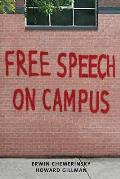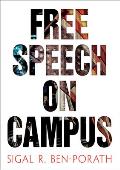Free Speech on Campus by Erwin Chemerinsky and Howard Gillman. New Haven, CT: Yale University Press, 2017.
Free Speech on Campus by Sigal R. Ben-Porath. Philadelphia: University of Pennsylvania Press, 2017.
These two short books (159 and 116 pages, respectively) share more than a common title. Both were clearly hurried into print in response to widely publicized campus free-speech controversies involving divisive outside speakers, hate speech, and student demands for “safe spaces” and “trigger warnings.” Each seeks to address “the tension . . . between the desire to protect the learning experience of all students and the desire to safeguard freedom of expression,” as Chemerinsky and Gillman put it, or, as Ben-Porath would have it, between “allowing or encouraging speech on matters of political and civic importance” and “maintaining a constructive atmosphere for learning and research.” They share as well a common commitment to the paramount importance of free expression, maintaining that unfettered speech and inclusive environments need not be incompatible.
Yet while the similarities are many, the approaches differ. Chemerinsky, currently dean of the law school at the University of California, Berkeley, and previously dean at UC Irvine, and Gillman, chancellor at Irvine and a constitutional scholar, offer a largely legal approach with brief histories of First Amendment jurisprudence, case law on hate speech, and a useful primer on “what campuses can and can’t do” under the law. Ben-Porath, professor of education, political science, and philosophy at the University of Pennsylvania, seeks to shift attention “from disputes about legality and harm and toward practical considerations linked to education and inclusion.” Both works are constructive, and I find more in their pages to agree with than to criticize. But neither is flawless, and at the risk of some distortion, I want to focus on some problems, especially in the Chemerinsky and Gillman book.
Chemerinsky and Gillman’s central argument is that “all ideas and views should be able to be expressed on college campuses, no matter how offensive or how uncomfortable they make people feel.” Their stance is “absolute: campuses never can censor or punish the expression of ideas, however offensive, because otherwise they cannot perform their function of promoting inquiry, discovery, and the dissemination of new knowledge.” Between “the absence of free thinking and a completely unregulated marketplace of ideas,” they argue, “there is no middle ground.” As both a legal argument applicable to public institutions and a general principle, this position is, in theory, more persuasive than not. But, as Ben-Porath’s book illustrates, applying it in practice is not always so simple, and the weaknesses of Chemerinsky and Gillman’s presentation suggest some reasons why.
According to Chemerinsky and Gillman, in recent years a “new censorship” has emerged in which the main culprits are “students who demand that the campus take action against speech they find offensive.” They claim that the list of incidents in which students have aggressively raised such demands “is almost endless.” But is it? In fact, the book comes close to exhausting the list of well-known anecdotes but fails to provide data suggesting that such demands have been truly widespread, much less effective or more dangerous than external threats to campus freedom. Some examples they cite do not really demonstrate the sort of intolerance the book suggests. For instance, Chemerinsky and Gillman recount how President Barack Obama castigated Rutgers University graduates for seeking to bar Condoleeza Rice from speaking at their commencement ceremony. But no such demand was made. The students were protesting not her speech but their exclusion from the speaker selection process, a totally legitimate concern. To be sure, there can be little doubt that student protesters sometimes threaten free expression. But I, for one, am not convinced that such threats pose a greater challenge than those emanating from powerful legislators, administrators, donors, and outside groups mobilizing harassment of both faculty and students.
Chemerinsky and Gillman contrast the current situation with past history, in which the main challenges to free expression came not from attempts to protect the vulnerable but from those in authority seeking to silence dissent. Here I think the authors paint an unduly rosy picture of resistance to such efforts. For instance, they claim that “professors did not lose their jobs for speaking out against the Vietnam War.” But while protections of tenure and academic freedom largely held in those days, some professors were indeed dismissed for their political activity, including Staughton Lynd at Yale; Oliver Lee at the University of Hawaii; Angela Davis at the University of California, Los Angeles; Bill Zimmerman at Brooklyn College; and Bruce Franklin at Stanford. They rightly uphold Berkeley’s 1964 Free Speech Movement as a watershed moment in opening campuses to “noncivilized and nonscholarly expression of ideas,” but they leave unmentioned that this was achieved only after students forcibly occupied the administration building, leading to more than eight hundred arrests. Instead, some pages later, they note without irony that “there is not a First Amendment right to occupy campus buildings.”
Chemerinsky and Gillman wisely distinguish the protection of academic freedom, “inextricably linked to professional standards and decorum,” from broader speech rights existing “outside scholarly and administrative settings and where the only restrictions are those of society at large.” Ben-Porath makes a similar point, reminding us that “free speech is not in fact a core value of the university. Academic freedom is a core value.” This is an important and useful distinction, but unfortunately Chemerinsky and Gillman do not always apply it consistently or explore its full implications. For instance, they argue that “colleges and universities can never punish the expression of ideas.” But clearly in what Chemerinsky and Gillman deem the “professional zone” governed by academic freedom these institutions can. The real difficulties arise in determining the border between that zone and the larger “free-speech zone,” and here Chemerinsky and Gillman do not offer much help.
In their review of what campuses can and cannot do to regulate expression, Chemerinsky and Gillman identify critical limits to their previously stated free-speech absolutism. Some of these, of course, are defined by First Amendment law, and while I suspect some legal scholars might read these cases differently, my inclination is to respect the authors’ judgment. But other potential limits are not prescribed by law. For instance, Chemerinsky and Gillman are more willing than many, including Ben-Porath, to limit student expression on social media, even when such expression is not directly related to campus activities.
Overall, Chemerinsky and Gillman offer a helpful guide for faculty and administrators seeking to navigate the legal implications of free-speech controversies as well as a vigorous and largely persuasive argument for the primacy of free expression. Unfortunately, however, that argument is weakened by their exaggeration of the alleged problem of student intolerance and by some imprecise formulations.
Ben-Porath’s book is both less focused on the law and less concerned about “the diminished value students attach to the protection of free speech.” Such concerns, she argues, “for the most part, are unwarranted.” Moreover, she suggests that colleges and universities must, in a sense, go beyond legal requirements. “Free speech on campus is not just another instance of free speech in the public sphere of a democratic nation,” she writes. “It is a special case in a special context.” Hence, “the legal framework alone cannot do all the work required to protect free speech on campus or to respond to challenges and violations of this principle.” For that reason, “most colleges, most of the time, resolve free speech issues through a fruitful, sometimes intense but still peaceful debate.”
Ben-Porath is especially useful in contextualizing free-speech controversies. She notes, for instance, how interference by state legislators or calls for outlawing the boycott, divestment, and sanctions movement targeting Israel may pose as great a danger as student demands to silence hate speech—or perhaps even greater. She also argues effectively, albeit a bit repetitively, against responding to free-speech controversies with appeals to “civility” and against a focus on disciplinary measures. She writes, “Couching free speech practices in the context of disciplinary measures is unproductive because the main issues are civic, relational, and educational rather than regulatory.”
Articulating an argument for what she calls “inclusive freedom,” Ben-Porath highlights not only the speech of those who may be silenced administratively or through protest but also those “effectively barred from speaking, when they avoid speaking their minds for fear of humiliation or ridicule, or when they do not feel that they belong or that they are appreciated.” This is an important corrective, or perhaps supplement, to Chemerinsky and Gillman. Ben-Porath also differs from the two Californians in her approach to online speech, which she finds “not fully comparable to other forms and contexts of speech” and mostly beyond the reach of campus regulation.
In her final chapter, Ben-Porath offers some “practical guidelines,” but here her argument is weaker. The suggestions she makes are mostly obvious, even clichéd, amounting at most to a series of “best practices.” Especially problematic is her proposal for “open expression monitors,” based on a volunteer program at her university. This may work well at Penn, but I am skeptical that it could resolve the sorts of thorny controversies that have prompted such vigorous debate.
Taken together, these books provide mostly complementary arguments and useful advice for faculty and administrators seeking to grapple with the issues they cover. However, both predate the horrific events in Charlottesville and the intensified threats of violence and intimidation on campus that have followed. Insofar as such threats are transforming the context of the discussion and pose new challenges to colleges and universities, the arguments made by these authors may to some extent already be inadequate.
Henry Reichman is professor emeritus of history at California State University, East Bay. He is first vice president of the AAUP, chair of Committee A on Academic Freedom and Tenure, and chair of the AAUP Foundation. His email address is [email protected].





